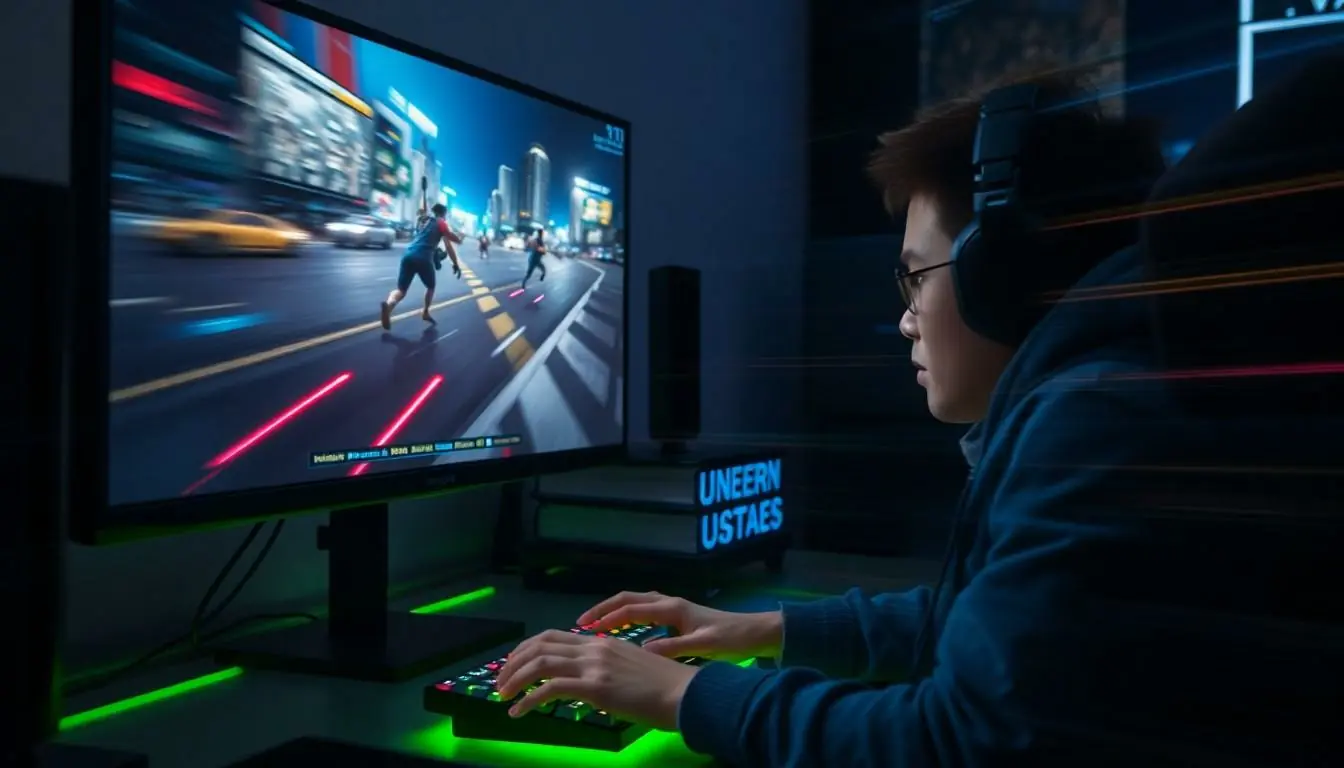In the fast-paced world of gaming, every frame counts, and players are always on the hunt for that elusive edge. Enter motion blur—a visual effect that makes the action look smoother but leaves many gamers scratching their heads. Does it really boost frames per second, or is it just a fancy trick to distract from lagging performance?
Table of Contents
ToggleUnderstanding Motion Blur
Motion blur refers to the visual effect where fast-moving objects appear smeared or blurred in a frame. It simulates how the human eye perceives motion, often adding realism to gaming experiences.
Definition of Motion Blur
Motion blur describes the apparent streaking of moving objects in a visual medium. It occurs when an image is captured over a period of time, causing rapid movements to appear as a blurred trail. This effect can enhance the perception of speed and fluidity in games, making scenes appear more dynamic. Gamers often notice motion blur during high-speed actions like running or turning quickly. By masking frame inconsistencies, this effect may distract from lower frame rates, improving the overall visual experience.
How Motion Blur Works
Motion blur operates on the principle of persistence of vision. When a camera or display shows an image, it doesn’t capture a single instant but rather a series of frames. Blending these frames creates the illusion of smooth motion. Many games use algorithms to generate motion blur, adjusting the effect based on speed and direction. As a result, faster objects exhibit more blur. Developers can control the intensity of motion blur, allowing players to customize their visual preferences. This customization may enhance immersion, particularly in fast-paced environments where quick reactions are essential.
The Relationship Between Motion Blur and FPS
Motion blur affects perceived frames per second in gaming. It creates a smooth visual transition during fast movements, which might make lower FPS appear more fluid.
Does Motion Blur Increase FPS?
Motion blur does not directly increase frames per second. It instead affects visual perception, giving the illusion of improved performance. Gamers might notice smoother animations and less jarring transitions due to the blurring effect. Some players favor this effect to enhance overall immersion, particularly in high-paced environments. Despite this, the actual frame rate remains unchanged, so performance issues may still exist behind the scenes.
Technical Mechanisms Behind FPS Increase
Motion blur operates by blending sequential frames during fast-motion sequences. Algorithms create a visual trail, adjusting based on movement speed and direction. By simulating continuous motion, the game compensates for quick movements that might otherwise reveal frame drops. Developers can fine-tune these algorithms to match gameplay dynamics, offering customization options to players. Such techniques enhance visual aesthetics without altering the fundamental frame rate.
Effects of Motion Blur on Gaming Experience
Motion blur significantly influences the gaming experience, particularly in the realm of visual effect and player immersion.
Visual Quality vs. Performance
Visual quality and performance maintain a delicate balance when it comes to gaming. Motion blur can enhance the overall aesthetic, presenting smoother transitions during rapid movements. Gamers may perceive higher fluidity in gameplay, even if the frame rate remains constant. Blurring visual artifacts can mask frame rate drops, creating an illusion of improved performance. Developers often incorporate motion blur to bridge the gap between fluctuating frames and immersive visuals. By fine-tuning motion blur settings, players can customize their experience, optimizing aesthetics without sacrificing performance.
Player Preferences and Perception
Player preferences about motion blur vary widely. Some gamers appreciate the realism it brings, feeling it enhances immersion during high-speed gameplay. Other players find it distracting, as they prefer crisp visuals over blurred artifacts. Personal perception shapes opinions on motion clarity significantly. Many players may choose to enable or disable motion blur based on their gaming style or comfort level. Preferences often stem from individual sensitivity to visual distractions, making it essential for developers to consider these factors. Ultimately, the impact of motion blur on gaming experience hinges on the player’s perception and choice, influencing their overall enjoyment and engagement.
Analyzing Motion Blur in Different Games
Motion blur plays a significant role in the visual experience across various game titles. Understanding how it affects performance requires examining real-world examples.
Case Studies: Games With Motion Blur
Several popular games implement motion blur to enhance visual performance. For instance, Call of Duty: Warzone utilizes motion blur effectively during high-speed chases, creating a smoother gameplay experience even at lower FPS. Forza Horizon 5 also employs motion blur to enhance the sensation of speed while racing. These titles demonstrate how motion blur can mask frame rate dips, allowing players to experience a more fluid motion. Players often report that their immersion levels increase, as this effect mimics natural vision.
Case Studies: Games Without Motion Blur
Many games omit motion blur for clarity in fast-paced environments. Counter-Strike: Global Offensive prioritizes sharp visuals, enabling players to spot enemies quickly and react effectively. StarCraft II follows a similar approach by maintaining crisp graphics, which allows players to strategize without distractions. These games highlight the importance of individual preferences, as some gamers prefer the clarity over the aesthetic appeal of motion blur. Performance can increase when motion blur is disabled, especially in competitive settings, where every frame counts for decisive outcomes.
Conclusion
Motion blur plays a significant role in shaping the gaming experience. While it doesn’t increase FPS directly, it enhances visual perception by creating smoother transitions during fast movements. This effect can mask frame rate drops and provide a more immersive environment, appealing to many players.
However, preferences vary widely among gamers. Some appreciate the realism and fluidity that motion blur offers, while others prefer the clarity of sharp visuals for competitive play. Ultimately, the choice to use motion blur depends on individual gaming styles and priorities, making it a personal decision that influences overall enjoyment.

